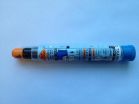How fast you walk and your grip in middle age may predict dementia, stroke risk
2012-02-16
(Press-News.org) NEW ORLEANS – Simple tests such as walking speed and hand grip strength may help doctors determine how likely it is a middle-aged person will develop dementia or stroke. That's according to new research that was released today and will be presented at the American Academy of Neurology's 64th Annual Meeting in New Orleans April 21 to April 28, 2012.
"These are basic office tests which can provide insight into risk of dementia and stroke and can be easily performed by a neurologist or general practitioner," said Erica C. Camargo, MD, MSc, PhD, with Boston Medical Center.
More than 2,400 men and women with an average age of 62 underwent tests for walking speed, hand grip strength and cognitive function. Brain scans were also performed. During the follow-up period of up to 11 years, 34 people developed dementia and 70 people had a stroke.
The study found people with a slower walking speed in middle age were one-and-a-half times more likely to develop dementia compared to people with faster walking speed. Stronger hand grip strength was associated with a 42 percent lower risk of stroke or transient ischemic attack (TIA) in people over age 65 compared to those with weaker hand grip strength. This was not the case, however, for people in the study under age 65.
"While frailty and lower physical performance in elderly people have been associated with an increased risk of dementia, we weren't sure until now how it impacted people of middle age," said Camargo.
Researchers also found that slower walking speed was associated with lower total cerebral brain volume and poorer performance on memory, language and decision-making tests. Stronger hand grip strength was associated with larger total cerebral brain volume as well as better performance on cognitive tests asking people to identify similarities among objects. "Further research is needed to understand why this is happening and whether preclinical disease could cause slow walking and decreased strength," said Camargo.
INFORMATION:
Learn more about dementia and stroke at http://www.aan.com/patients.
The study was supported by the National Heart, Lung and Blood Institute's Framingham Heart Study and by the National Institute of Neurological Disorders and Stroke and the National Institute on Aging.
The American Academy of Neurology, an association of more than 25,000 neurologists and neuroscience professionals, is dedicated to promoting the highest quality patient-centered neurologic care. A neurologist is a doctor with specialized training in diagnosing, treating and managing disorders of the brain and nervous system such as stroke, Alzheimer's disease, epilepsy, Parkinson's disease and multiple sclerosis. For more information about the American Academy of Neurology, visit http://www.aan.com or find us on Facebook, Twitter, Google+ and YouTube.
Media Contacts:
Rachel Seroka, rseroka@aan.com, (651) 695-2738
Angela Babb, APR, ababb@aan.com, (651) 695-2789
END
ELSE PRESS RELEASES FROM THIS DATE:
2012-02-16
A new study has examined how smoking-cessation aide varenicline may reduce drinking.
Results indicate that varenicline may reduce drinking by increasing alcohol's aversive effects.
Specifically, varenicline may increase blood pressure, heart rate, as well as ratings of dysphoria and nausea.
Varenicline is an effective smoking-cessation medication that may also reduce drinking. However, the means by which it might reduce drinking is unclear. A study of the effects of varenicline on subjective, physiological, and objective responses to low and moderate doses of alcohol ...
2012-02-16
Alcohol abuse and dependence are common problems in the United States due to a number of factors, two of which may be social drinking by college students and young adults, and risk taking that may lead to heavier drinking later in life. A study of the neural underpinnings of risk-taking in young, non-dependent social drinkers has found that the caudate nucleus and frontal cortex regions of the brain show less activation in people who drink more heavily.
Results will be published in the May 2012 issue of Alcoholism: Clinical & Experimental Research and are currently ...
2012-02-16
Frequent drinking can establish changes in the processing of alcohol cues that can, in turn, facilitate renewed drinking unless the resulting impulse to drink is inhibited.
A new study has looked at the interaction between automatically activated approach tendencies and adolescent ability and motivation to inhibit and reflect upon drinking behaviors.
Results show that stricter parental rules about drinking are highly protective, especially for males.
Frequent drinking can lead to changes in the processing of alcohol cues that can, in turn, facilitate renewed drinking ...
2012-02-16
Intimate partner violence (IPV) has been linked to heavy drinking, and alcohol outlet density to violence.
A new study looks at links between alcohol outlet densities and IPV-related Emergency Department (ED) visits.
Findings showed that bars are positively related to IPV-related ED visits, while there is no relationship between restaurant density and IPV-related ED visits.
Intimate partner violence (IPV) has been linked to heavy drinking, substance use by one or both partners, and living in a neighborhood characterized by poverty and social disadvantage. Alcohol ...
2012-02-16
Women with peripheral artery disease, or PAD, are two to three times more likely to have a stroke or heart attack than those without it ― yet it's often unrecognized and untreated, especially in women, according to a new American Heart Association scientific statement.
The statement is published in Circulation: Journal of the American Heart Association.
The American Heart Association, in collaboration with the Vascular Disease Foundation and its Peripheral Artery Disease Coalition, recommends healthcare providers proactively increase awareness of and test women ...
2012-02-16
Hamilton, ON - For decades, the blood thinner heparin has been used to prevent and treat blood clots. Could it be just as effective in treating cancer?
In an editorial published today in the New England Journal of Medicine, researchers from McMaster University and the University at Buffalo suggest conclusive answers to key questions on the benefits of low molecular weight heparin (LMWH) for cancer patients remain elusive - despite promising results from large studies.
Co-authors of the editorial are Dr. Elie Akl, associate professor in the Department of Medicine in ...
2012-02-16
According to the World Health Organization (WHO), one-third of the world's population is currently infected with tuberculosis bacteria. The bacteria is incredibly resistant to treatment, and despite its prevalence, very little is known about why it is so stress tolerant. But, researchers at the University of Pittsburgh have been developing a new way of culturing tuberculosis bacteria, which could lead to new insights and treatments.
"This is a significant step forward in TB research," said paper-author Dr. Anil Ojha, "because it shows in a very reproducible way how to ...
2012-02-16
The Taurus Molecular Cloud, in the constellation of Taurus (The Bull), lies about 450 light-years from Earth. This image shows two parts of a long, filamentary structure in this cloud, which are known as Barnard 211 and Barnard 213. Their names come from Edward Emerson Barnard's photographic atlas of the "dark markings of the sky", compiled in the early 20th century. In visible light, these regions appear as dark lanes, lacking in stars. Barnard correctly argued that this appearance was due to "obscuring matter in space".
We know today that these dark markings are actually ...
2012-02-16
UPTON, NY - Brain scans of two strains of mice imbibing significant quantities of alcohol reveal serious shrinkage in some brain regions - but only in mice lacking a particular type of receptor for dopamine, the brain's "reward" chemical. The study, conducted at the U.S. Department of Energy's Brookhaven National Laboratory and published in the May 2012 issue of Alcoholism: Clinical and Experimental Research, now online, provides new evidence that these dopamine receptors, known as DRD2, may play a protective role against alcohol-induced brain damage.
"This study clearly ...
2012-02-16
Drug delivery into muscle using an autoinjector, akin to the EpiPen used to treat serious allergic reactions, is faster and may be a more effective way to stop status epilepticus, a prolonged seizure lasting longer than five minutes, according to a study sponsored by the National Institutes of Health. Status epilepticus is a potentially life-threatening emergency that causes 55,000 deaths each year. Anticonvulsant drugs are typically delivered intravenously (IV) as a first-line treatment.
Starting an IV in a patient experiencing seizures can pose a challenge for paramedics ...
LAST 30 PRESS RELEASES:
[Press-News.org] How fast you walk and your grip in middle age may predict dementia, stroke risk

